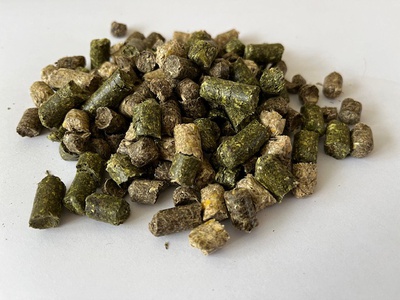Hay-alfalfa-corn pellets 8mm
TOTAL BALANCE
Ingredients: 33% 8mm meadow hay pellets; 33% 8mm dehydrated whole corn plant pellets (including stems, leaves, and cobs with grain); 33% 8mm dehydrated alfalfa hay pellets.
Packaging: big bags, 20kg paper bags.
- The advantage of this totally natural mix product lies in the high proportion of crude fibre with a high energy density, balanced protein content, and high content of vitamins and minerals.
- This releases the energy in the large intestine slowly and steadily. This is a significant benefit for horses that need endurance, such as in the fields of eventing, steeplechasing, and carriage driving.
- No added sugar or molasses. No synthetic or artificial additives.
Values on dry matter:
| Pellet diameter, mm |
8mm |
| Moisture,% |
max 13 |
| Crude protein, % |
min 10 |
| Crude fiber, % |
max 30 |
| Sugars, % |
max 7 |
| ME-horse, MJ/kg |
min 6 |
Indicative values* on dry matter:
- Moisture - 9.3%
- Crude protein - 12.4%
- Crude fiber - 27.9%
- Sugars - 5.4%
- Fruktan - 1.1%
- Crude fat - 2,3%
- Crude ash - 6.8%
- Starch - 13.2%
- Sand < 1,0%
- ME-Horse - 7.8 MJ/kg
- pcd CP (praec.digest. crude prot.) - 8.4%
- Phosphorous (P) – 0.29%
- Calcium (Ca) – 1.0%
- Potassium (K) – 1.52%
- Magnesium (Mg) – 0.23%
- Sodium (Na) < 0.02g/kg
- Sulfur (S) – 0.19%
- Copper (Cu) - 6 mg/kg
- Zink (Zn) - 23 mg/kg
- Mangan (Mn) - 64 mg/kg
- Iron (Fe) - 233 mg/kg
* values may vary depending on field and time of cutting.
Application for horses:
- As a supplement: pellets can be fed alongside regular hay to provide extra calories and protein. Feed 0,5-2,5 kg per day, depending on the horse's needs.
- As a forage replacement: if the hay is limited, these pellets can replace a portion of the forage at 1,5-2% of body weight per day, split into multiple meals.
We recommend soaking in the water before feeding in ratio 1kg of the product to 2-3 liters of water and to find the best way of product preparation for your animals.
The product must be stored under sound conditions, protected from heat, moisture and risk of condensation.
